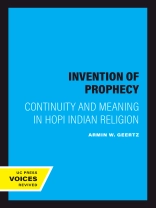Armin Geertz corrects what he sees as basic American and European tendencies to misrepresent non-Western cultures. Carefully documenting the historical role of prophecy in Hopi Indian religion, Geertz shows how prophecies about the end of the world have been created by the Hopi Traditionalist Movement and used by non-Indian movements, cults, and interest groups. Many of the seeming peculiarities of Hopi religion and culture have been invented, he says, by tourists, novelists, journalists, and scholars, and the millennial Traditionalist Movement has subtly co-authored European and American stereotypes of Indians. Geertz’s richly detailed examples and persuasive arguments will be welcomed by all those interested in Native American studies, comparative religions, anthropology, and sociology.
Armin Geertz corrects what he sees as basic American and European tendencies to misrepresent non-Western cultures. Carefully documenting the historical role of prophecy in Hopi Indian religion, Geertz shows how prophecies about the end of the world have b
O autorze
Armin W. Geertz is a Professor in the Department of the Study of Religion at the University of Aarhus, Denmark, and has written several other books on Hopi religion and art.







![Pokrywa Brian Schrag & Julisa Rowe: Community Arts for God's Purposes [Chinese] 貼近神心意的社群藝術 Pokrywa Brian Schrag & Julisa Rowe: Community Arts for God's Purposes [Chinese] 貼近神心意的社群藝術](https://static.worldofdigitals.com/thumb_webp/740/9781645083740.webp)




